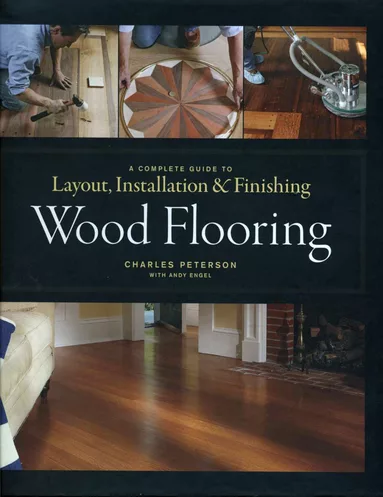Wet Room Installation Tips and Best Practices
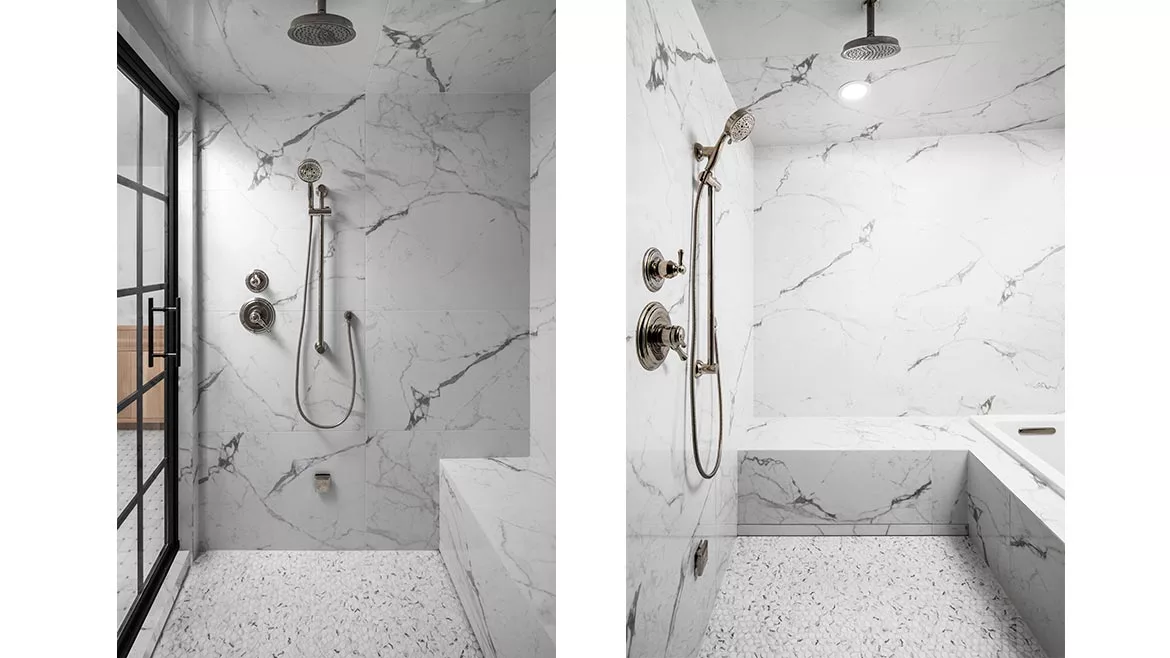
Constructed Matter, Inc. Completed a steam shower/wet room during a master suite renovation, incorporating the QuickDrain WallDrain linear drain system into a bench seat.
Photo: Kyle Zirkus Photography.
Wet rooms have become increasingly popular, especially in bathrooms where the bathtub and shower are combined. However, there are different installation and design considerations to keep in mind when waterproofing and tiling a wet-room application.
We will discuss the key factors to consider when installing wet rooms and share some best practices for tile and flooring contractors to ensure a successful installation.
Curbed versus Curbless Wet Rooms
Concerning wet-room applications, there is a preference for curbed over curbless showers. The reason for this lies in the installation process and ensuring proper drainage.
In wet rooms with a bathtub and shower combined, it is easier to install a curbed shower with a linear drain because the floor is not recessed.
The bathtub is placed on the higher side of the room, allowing for a one-slope pitch toward the linear drain on the opposite side of the room. In this case, the tub would be placed on the right, and the drain would be placed on the far left with coverage from wall to curb.
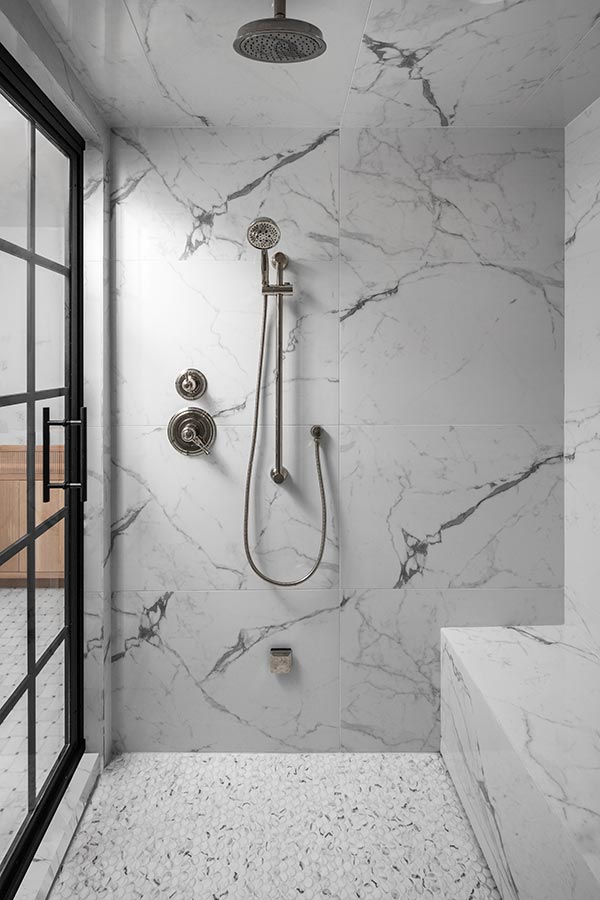
Photo: Kyle Zirkus Photography.
The floor can then be easily sloped from the highest point where the tub sits toward the drain on the left side of the room. This ensures that any water from the shower flows towards the drain efficiently and avoids any uneven slopes or awkward drainage configurations.
However, the installation process becomes trickier when it comes to curbless wet rooms. To maintain the same plane for both the shower and tub, the floor needs to be recessed. This is to create a level surface where the tub can be placed.
In these cases, a square drain is often used instead of a linear drain, because the former allows for proper drainage in all directions.
While curbless wet rooms may be gaining popularity, most wet-room installers still prefer curbed showers. The ease of installation, adequate drainage, and maintaining the same plane for the shower and tub are key factors driving this preference.
But in both curbed and curbless applications, be sure the floor is correctly pitched towards the drain to prevent water pooling. The general rule of thumb is to have a minimum slope of ¼” per foot leading toward the drain.
Ideal for wet room applications, the ShowerLine PVC linear drain from QuickDrain offers a cutting-edge look and sleek design. The integrated PVC drain, combined with pre-sloped shower panels and waterproofing accessories, represents a total shower solution for promoting effective and efficient drainage. The pre-sloped shower pan and waterproofing kits for use with QuickDrain’s ShowerLine series linear drains are a time-saving alternative to traditional mortar bed tile installations.
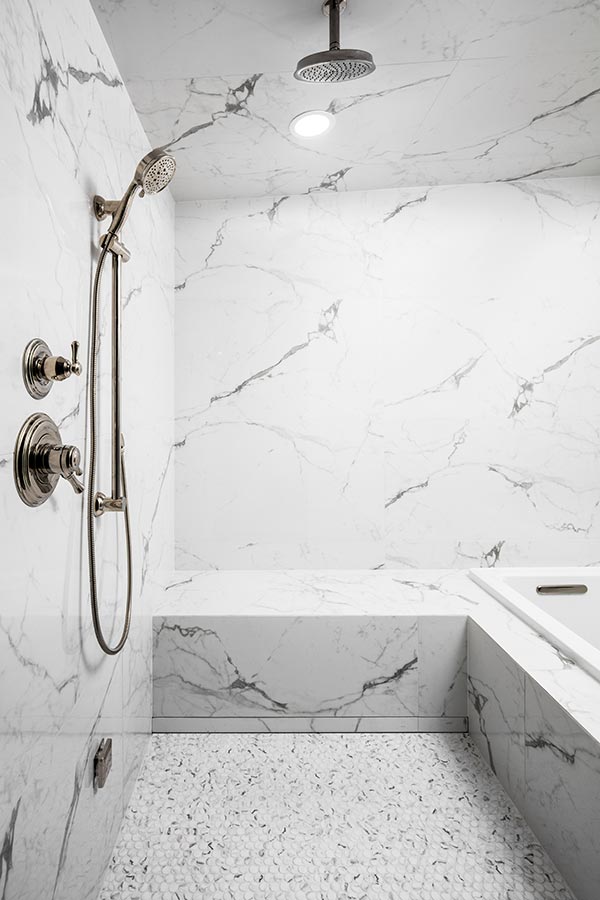
Photo: Kyle Zirkus Photography.
Another option is QuickDrain’s unique WallDrain linear shower drains built into the wall, offering a totally concealed and sleek look. The all-in-one assembly kit includes everything needed to bring the wet room shower design to life, while also providing exceptional flexibility and customization.
Constructed Matter, Inc., an Arizona-based design + build firm that specializes in delivering design-centric commercial and residential projects, recently installed a WallDrain linear drain in a wet room during a master suite renovation.
The pre-sloped PET pans have an interlocking design that can be quickly and easily modified to any size or shape directly on-site. Comprised of extruded rigid PET (polyethylene terephthalate) plastic foam, the lightweight and shatterproof shower pans or panels are constructed from 100% post-consumer plastic water bottles.
Proper Sealing and Waterproofing
Proper sealing and waterproofing are crucial elements when it comes to wet rooms. These rooms have various penetrations through the floor for water lines, drains, and tubs, so everything must be sealed and waterproofed to prevent leaks and damage.
Traditional PVC liners are not commonly used for wet-room waterproofing. Instead, topical waterproofing systems, such as topical fabric or elastomeric liquid waterproofing, are favored. These allow for a seamless application and provide a completely waterproof envelope for the wet room. These seamless products are like painting a wall; once it dries, it becomes one piece, making for easier waterproofing and a more reliable seal.
It is important to note that even the edges of the bathtub need to be sealed to the floor. While the tub is usually on the higher side and should not come in direct contact with water from the shower, it is essential for flood-test inspection purposes to ensure proper sealing.
Invest in high-quality waterproofing products designed for wet-room installations. Follow the manufacturer's instructions for application and ensure that all surfaces, joints, and corners are adequately sealed and waterproofed.
Drain Selection and Placement
Choosing the right drain is crucial for wet-room installations. While various types of drains are available, it is recommended to use larger linear drains, such as those offered by QuickDrain, especially for wet rooms with higher water volumes.
The larger size of these drains allows for wall-to-wall coverage, minimizing the need for grout and providing a seamless look. The use of larger drains also eliminates the need for cutting tiles to fit around a smaller drain, saving time and labor costs.
Proper drain placement is crucial for effective water drainage in wet rooms. Let’s look at three placement alternatives:
Central placement: A centrally located drain is a popular choice, as it allows for efficient water drainage from all areas of the wet room. This placement ensures that the water flows towards the drain from all directions, minimizing the risk of standing water and allowing for easier cleaning. However, as mentioned earlier, a center drain could pose some installation challenges, such as keeping the tub level at the highest part of the floor and then properly sloping the floor toward the drain from four different directions.
Offset placement: In some cases, an offset drain placement may be necessary, due to either structural constraints in the existing space or owner design preferences. When opting for an offset drain, it is important to consider the location of the main water source, the slope of the floor, and how water will flow toward the drain. QuickDrain linear drains have a site-sizable linear drain body that can be customized to adapt to existing drain locations while also covering up off-center drains. Extensions and covers may be trimmed onsite after the PVC body is installed, making it easy to create wall-to-wall coverage.
Linear drain placement: Linear drains can provide a sleek and modern look to wet rooms. Typically placed against one wall or along one edge of the room, linear drains offer flexibility in design and tile installation because they can be placed at different positions to create a custom shower area.
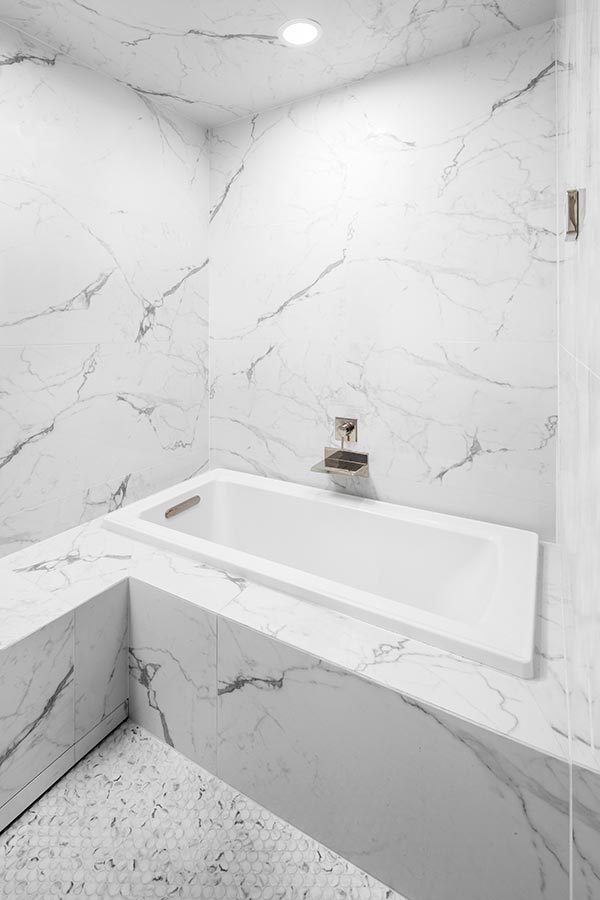
Photo: Kyle Zirkus Photography.
Tile Selection
Porcelain or ceramic tiles are recommended for wet rooms, rather than natural stone. This recommendation is particularly true for wet rooms with steam showers, as natural stone is super porous, which can cause mold growth over time. The steam from the shower can push through the tile and the waterproof layer behind, causing potential moisture issues.
However, if it's not a room with a steam shower, tile such as travertine, quartz or marble can be used without issues.
Choosing suitable tiles for a wet room requires careful consideration, as you don't want to compromise the waterproofing. This means that porcelain or ceramic tiles are the safest option for wet rooms, but thanks to technological advancements, tiles are available that mimic natural stone's appearance. These tiles offer the best of both worlds, providing a natural stone look without the potential moisture issues.
Additional Tips
- Pitch the ceiling: For wet rooms with steam showers, it’s vital to ensure the ceiling is pitched correctly to avoid water dripping on top of the homeowner while using the shower.
- Maintenance: Wet rooms require regular maintenance to keep them clean and in good condition. Advise your customers to clean the tiles and grout regularly, using appropriate cleaning products and techniques. They should also promptly address any leaks or damage to prevent further issues.
See more articles on installing showers and wet rooms
Design Custom Shower Installations with These Four Products
Navigating New Trends: Embracing the Shift in Residential Shower Installations
Looking for a reprint of this article?
From high-res PDFs to custom plaques, order your copy today!




